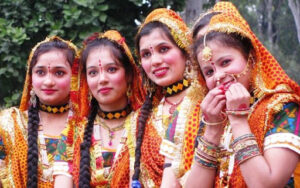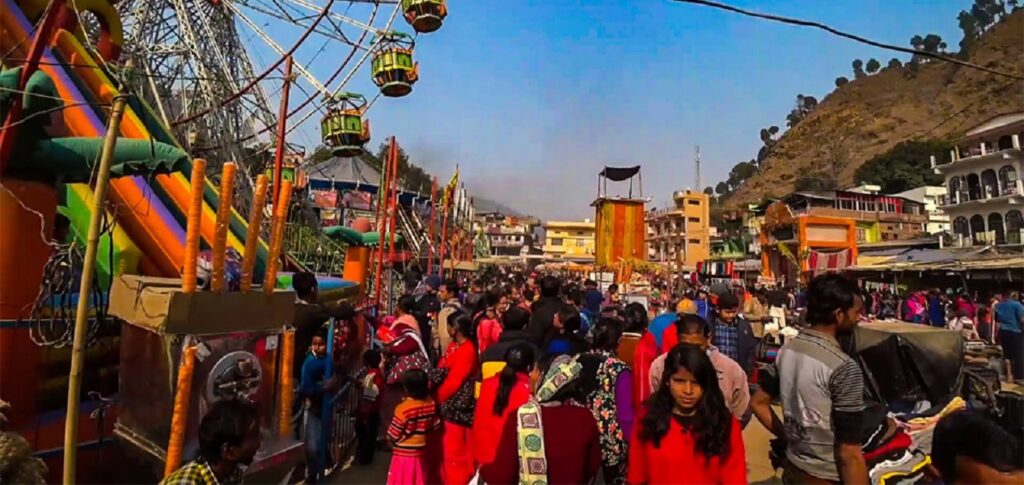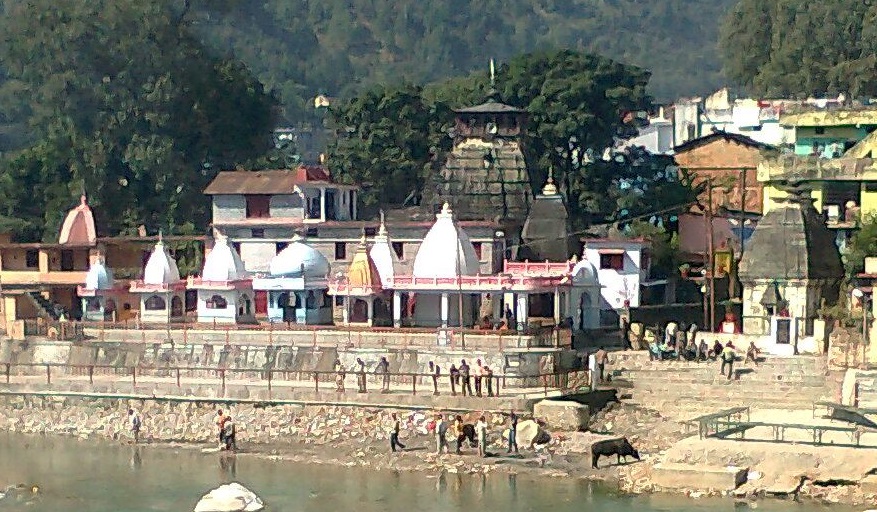Uttarakhand is a land where festivals are not just celebrations but a way of life, embodying the rich tapestry of its culture and traditions. Among these, the Uttarayani Festival, also known as Ghughutiya or Makar Sankranti, holds a special place in the hearts of the people of Uttarakhand, particularly in the Kumaon region.
Uttarayani, celebrated on the auspicious day of Makar Sankranti, marks a significant astronomical event – the sun’s northward journey in the celestial sphere. This festival, falling in mid-January, is a confluence of reverence, joy, and community spirit. It’s a time when the chill of the winter begins to wane, and the warmth of the sun brings new hope and joy.
In the vibrant valleys and serene hills of Kumaon, Uttarayani is not just a day’s affair but a celebration that encapsulates the essence of tradition, faith, and communal harmony. The festival is synonymous with the famous Uttarayani Fair, held in various parts of the region, with the most prominent one at Bageshwar, on the banks of the sacred River Saryu.
Significance in Uttarakhand’s Culture

For the people of Uttarakhand, Uttarayani is more than just a change in the celestial cycle; it’s a celebration of life itself. It’s a day when the skies are adorned with colorful kites, symbolizing freedom and joy. The festival is deeply rooted in the agrarian culture of the region, marking the end of the harvest season and the onset of a new agricultural cycle. Farmers express their gratitude for the past harvest and pray for prosperity in the coming year.
The festivals in Uttarakhand is also a time for social gatherings, where people, dressed in their traditional attire, come together, transcending the barriers of caste and class. It’s a day when the air resonates with the melodies of folk songs and the rhythm of dances, reflecting the rich cultural heritage of the region.
Historical Background
The origins of Uttarayani are as old as the hills themselves, intertwined with myths, legends, and the very fabric of Hindu astrology. The festival is linked to the movement of the sun from the Tropic of Capricorn (Makar) to the northern hemisphere, marking the end of the winter solstice and the beginning of longer days.
Historically, the festival has been a significant event in the Kumaon region, dating back to the era of the Chand Kings. It was not just a religious festival but also an important event for the community, where decisions regarding the village were made, and local issues were discussed. The fair held during Uttarayani was, and still is, a major event for trade and commerce, attracting traders and artisans from far and wide.
In essence,
Uttarayani or Ghughutiya, as it is locally known, is a festival that weaves together the cultural and historical ethos of Uttarakhand. It’s a time when the past and present merge, traditions are revered, and the spirit of togetherness is celebrated. The festival stands as a testament to the enduring legacy of the region’s customs, echoing the rhythms of life, nature, and the cosmos in the serene Himalayan landscape.
Uttarayani and the Chand Kings
The celebration of Uttarayani in Uttarakhand is deeply intertwined with the region’s history, particularly with the era of the Chand Kings, who ruled over the Kumaon region for several centuries. The Chand dynasty, known for its patronage of art and culture, played a significant role in shaping the traditions and customs associated with Uttarayani.
Under the reign of the Chand Kings, Uttarayani flourished not just as a religious and cultural festival but also as a significant event for social and political gatherings. It was during their rule that the Uttarayani Fair, especially in Bageshwar, gained prominence. These fairs were not only about trade and commerce but also served as venues for public hearings and administrative decisions. The kings often used this occasion to address public grievances, announce new policies, and interact with the common people, thereby strengthening their connection with their subjects.
The Chand Kings were also instrumental in promoting the arts and culture associated with Uttarayani. They encouraged the performance of traditional music, dance, and folklore, enriching the festival’s cultural fabric. The patronage provided by the Chand dynasty helped preserve many art forms and rituals that might have otherwise been lost in the annals of history.
Spiritual Beliefs Associated with Uttarayani
Uttarayani, deeply ingrained in the spiritual fabric of Uttarakhand, is more than a mere celebration; it’s a profound expression of the region’s spiritual beliefs and practices. This festival is closely tied to the Hindu solar calendar, marking a pivotal shift in the sun’s celestial path. The transition from Dakshinayan (the sun’s southward movement) to Uttarayan (the sun’s northward movement) is not just an astronomical phenomenon but a spiritual transition that holds immense significance in Hindu philosophy.
In Hindu mythology, Uttarayan is considered a period of enlightenment, auspiciousness, and spiritual awakening. It’s believed that during this time, the gates of heaven are open, making it an ideal period for spiritual practices and attaining higher levels of consciousness. The sun, revered as a symbol of divinity and wisdom, is worshipped for its life-giving energy and its role in sustaining the earth.
The festival of Uttarayani is thus a time for introspection, spiritual renewal, and purification. Taking a dip in the holy rivers, especially in the confluence of the Ganges and Saryu in Bageshwar, is a ritual that holds immense significance. It’s believed that this act purifies the soul, washes away sins, and brings blessings from the divine.
The Transition from Dakshinayan to Uttarayan
The transition from Dakshinayan to Uttarayan is a moment of cosmic shift that is celebrated across various cultures in India, but in Uttarakhand, it takes on a unique and profound meaning. Dakshinayan, associated with the night, is considered a period of negative energy, whereas Uttarayan, associated with the day, symbolizes positivity and growth. This transition is metaphorically seen as a journey from darkness to light, ignorance to knowledge, and despair to hope.
Uttarayani, therefore, is not just a celebration of the sun’s journey but a celebration of life’s eternal cycle of renewal. It’s a time when the people of Uttarakhand embrace the warmth of the sun, leaving behind the cold and darkness of winter. The festival symbolizes new beginnings, the rekindling of hope, and the joy of life’s continuous rhythm.
In the cultural tapestry of Uttarakhand, Uttarayani is a vibrant thread that binds the community in a shared experience of reverence, joy, and hope. It’s a time when the spiritual and the temporal converge, and the people of this Himalayan state celebrate the divine dance of the cosmos, echoing the eternal cycle of time and life.
Legacy in Modern Celebrations
The legacy of the Chand Kings continues to be felt in the modern celebrations of Uttarayani. The grandeur and scale of the fairs, the emphasis on cultural performances, and the spirit of community interaction can all be traced back to the traditions established during their rule.
Today, the Uttarayani Fair still serves as a crucial platform for local artisans, performers, and traders, echoing the historical significance of these fairs as centers of commerce and culture. The administrative and social aspects of the fair might have evolved, but the essence of bringing together communities remains unchanged.
The influence of the Chand Kings is also evident in the preservation of traditional art forms. The songs, dances, and rituals performed during Uttarayani are a reflection of the region’s rich cultural heritage, much of which was nurtured under the Chand dynasty. These traditions have been passed down through generations and continue to be an integral part of the festival.
In essence, the legacy of the Chand Kings in the celebrations of Uttarayani is a testament to their impact on the cultural and social landscape of Kumaon. Their influence helped shape Uttarayani into a multifaceted festival that goes beyond religious significance to encompass cultural, social, and historical dimensions. The modern celebrations of Uttarayani, while reflective of contemporary times, still carry the echoes of the past, preserving the rich legacy of the Chand dynasty in the heart of Uttarakhand.
Ghughutiya Tyohar and Ghughuti Mala

At the heart of the Uttarayani celebrations in Uttarakhand lies the delightful and unique tradition of Ghughutiya. This tradition is particularly cherished in the Kumaon region and adds a distinct flavor to the festival. Ghughutiya, also known as “Kale Kauwa” in the local dialect, is celebrated on the eve of Makar Sankranti, coinciding with Uttarayani.
The term ‘Ghughutiya’ refers to a special type of sweet delicacy, which is the centerpiece of this tradition. These sweets, called ‘Ghughute’, are made from a dough of wheat flour, sweetened with jaggery, and deep-fried in ghee. What makes them unique is their shape – they are crafted into various forms such as drums, pomegranates, knives, swords, and most notably, the shapes of birds, particularly crows.
Ghughuti Mala, on the other hand, is a garland made of these Ghughute sweets. Children wear these garlands around their necks during the festival. The garlands often have an orange or a lemon tied at the center, adding to their visual appeal and symbolic significance.
Significance in the Festival
The Ghughutiya tradition is imbued with deep cultural and emotional significance. It is a celebration that is particularly beloved by children. On the day of Ghughutiya, children go from house to house, singing traditional songs that invite crows to partake in the Ghughute. This practice is symbolic of feeding the birds, an act that is believed to bring good luck and blessings.
The shapes of the Ghughute, especially the crow, hold a special place in the local folklore. The crow is considered a messenger, and feeding crows during Ghughutiya is thought to be a way of sending messages to departed ancestors, seeking their blessings for the family. This practice reflects the deep respect for nature and the interconnectedness of life and the afterlife in the local belief system.
Moreover, the Ghughutiya tradition is a reflection of the community’s agricultural roots. The sweets, made from the produce of the harvest, are a celebration of the bounty that the land provides. The sharing of Ghughute among families and neighbors fosters a sense of community and togetherness, reinforcing social bonds.
In essence, the Ghughutiya tradition during Uttarayani is a beautiful amalgamation of joy, reverence, and community spirit. It encapsulates the essence of Uttarakhand’s culture, where traditions are not just preserved but are lived with joy and enthusiasm, connecting the past with the present, and the living with the ancestral spirits.
The Making and Sharing of Ghughute
The star of Uttarayani’s culinary show is undoubtedly the ‘Ghughute’, a traditional sweet unique to the festival. Made from wheat flour and shaped into various forms such as drums, pomegranates, knives, swords, and birds, Ghughute is a delight both in terms of taste and aesthetics.
The making of Ghughute is a family activity, often involving multiple generations. It’s a time for bonding, storytelling, and passing down recipes and techniques from the elders to the younger members. The process of kneading the dough, shaping the Ghughute, and then frying them is imbued with love and care, making these sweets more than just a treat for the palate but a symbol of familial warmth and togetherness.
Once prepared, Ghughute are not just consumed within the family; they are also shared with neighbors, friends, and extended community members. This act of sharing is a significant aspect of the festival, reinforcing social bonds and the spirit of community. In many households, Ghughute are strung into garlands and given to children, adding a playful and joyous element to the tradition.
Moreover, the sharing of Ghughute extends beyond the human community. As part of the Ghughutiya tradition, these sweets are offered to birds, especially crows, in a gesture that signifies respect for nature and the interconnectedness of all life forms. This practice reflects the deep ecological consciousness inherent in the local culture and adds a layer of spiritual significance to the culinary traditions of Uttarayani.
In essence, the culinary delights of Uttarayani, particularly the making and sharing of Ghughute, embody the essence of the festival – a celebration of harvest, a tribute to nature, and a testament to the joy of sharing and community living. These traditional foods and sweets are not just nourishment for the body but also for the soul, weaving together the rich tapestry of Uttarakhand’s cultural and culinary heritage.
The Uttarayani Fair in Bageshwar

The Uttarayani Fair, held in various parts of the Kumaon region, is a vibrant and bustling event that forms the core of the Uttarayani celebrations. The most significant of these fairs takes place in Bageshwar, a town that becomes a hub of cultural and social activity during this time.
The fair is a kaleidoscope of colors, sounds, and experiences. It’s a place where the cultural heritage of Uttarakhand comes alive through various activities and attractions. Artisans from across the region come to display and sell their crafts, including iron and copper vessels, baskets, casks, bamboo articles, mats, mattresses, carpets, blankets, herbs, and spices. The fair serves as an important commercial event, providing a platform for local artisans and traders to showcase and sell their products.
Cultural performances are a significant highlight of the Uttarayani Fair. Folk artists perform traditional songs and dances like Jhoras, Chancharis, and Bairas, drawing large crowds. These performances are not just entertainment but a living expression of the region’s rich cultural legacy.
Another key attraction is the variety of local cuisine available at the fair. Visitors can savor traditional Kumaoni dishes and sweets, including the famous Ghughute, adding a delightful flavor to the experience.
Importance of Bagnath Temple in Bageshwar

At the heart of the Uttarayani Fair in Bageshwar is the Bagnath Temple, a revered site that adds a spiritual dimension to the festivities. This ancient temple, dedicated to Lord Shiva, is situated at the confluence of the Saryu and Gomti rivers. During Uttarayani, the temple becomes a focal point of devotion and celebration.
The significance of Bagnath Temple during the Uttarayani Fair is profound. Pilgrims and devotees throng the temple to offer prayers and seek blessings. The act of taking a dip in the confluence of the rivers near the temple is considered especially auspicious during this time. It is believed that such a dip purifies the soul and brings spiritual merit.
The temple’s historical and mythological significance adds to the fair’s allure. According to legend, it is at this spot that Lord Shiva roamed as a tiger, and it’s here that the sage Markandeya offered his prayers to Shiva. The temple, with its rich history and spiritual aura, provides a perfect backdrop to the Uttarayani Fair, blending devotion with celebration.
In conclusion, the Uttarayani Fair is not just a festive event but a microcosm of Uttarakhand’s cultural and spiritual ethos. It’s a place where commerce, culture, and spirituality intertwine, offering a unique experience to both locals and visitors alike. The fair, with the Bagnath Temple at its core, stands as a symbol of the region’s enduring traditions and the unifying power of communal celebrations.
Celebrations Across Kumaon
The Kumaon region of Uttarakhand, with its picturesque landscapes and rich cultural heritage, celebrates Uttarayani with great enthusiasm and distinct flavors across its various towns and villages. Each area adds its unique touch to the festival, making it a diverse and vibrant tapestry of cultural expression.
In Almora, the Uttarayani Fair is marked by a grand procession and a host of cultural activities. The town, known for its rich history and artistic heritage, becomes a bustling center where traditional music and dance performances take center stage. Artisans and craftsmen from nearby villages come to display and sell their unique handicrafts, turning the town into a colorful bazaar.
Ranibagh, another key location for the celebrations, hosts a fair that is a blend of religious fervor and communal joy. Here, the focus is as much on the spiritual aspects of the festival as on the social and cultural gatherings. Devotees engage in ritualistic baths in the holy rivers, followed by prayers and offerings at local temples.
In Hanseswari, the festival takes a more intimate turn, with communities coming together to celebrate with local games, folk songs, and dances. The spirit of camaraderie and community bonding is palpable, with people sharing meals and stories, reinforcing social ties.
Unique Customs and Practices
One of the unique aspects of the Uttarayani celebrations in Kumaon is the tradition of ‘Baithaki Holi’ or ‘Sitting Holi’, which begins from the day of Uttarayani. Unlike the typical Holi celebrations, this involves groups of people sitting together and singing traditional Holi songs accompanied by musical instruments, a practice that continues until the main Holi festival.
Another distinctive practice is the ‘Boli’ singing, where groups of men and women sing call-and-response songs, often with playful and humorous undertones. These songs are an integral part of the cultural fabric of Kumaon and add a lively atmosphere to the festivities.
In some parts of Kumaon, Uttarayani is also a time for traditional sports and games. Villages organize competitions like wrestling (Dangal) and Kabaddi, which see enthusiastic participation from the youth. These games are not just about physical prowess but also about building community spirit and sportsmanship.
The making and flying of kites is another practice that is synonymous with Uttarayani in Kumaon. Skies are adorned with colorful kites, and the activity is enjoyed by both children and adults, symbolizing freedom and joy.
In conclusion, the celebrations of Uttarayani across Kumaon are a vivid display of the region’s cultural richness. Each town and village, with its unique customs and practices, contributes to the mosaic of this grand festival, making it an embodiment of the region’s spirit and heritage.
The Tradition of Kite Flying During Uttarayani
Kite flying during Uttarayani is a tradition that paints the skies of Uttarakhand with vibrant colors and joy. This activity, particularly prominent in the Kumaon region during the festival, is not just a pastime but a significant cultural and symbolic practice that resonates deeply with the spirit of Uttarayani.
As the sun begins its northward journey, marking the onset of longer days, the clear, crisp skies of January provide the perfect backdrop for kite flying. This tradition is embraced by people of all ages, with rooftops and open fields becoming arenas for both skilled kite flyers and enthusiastic beginners. The skies are dotted with kites of various sizes, shapes, and colors, creating a spectacle that is as visually stunning as it is culturally significant.
Symbolism and Enjoyment
The act of kite flying during Uttarayani is laden with symbolism. It is seen as a representation of reaching out to the heavens, an act of sending messages to the gods, and a symbolic gesture of touching the divine. The kites soaring high in the sky symbolize the human spirit’s aspiration to rise above the mundane, reaching towards higher realms of consciousness and freedom.
Moreover, kite flying is also a metaphor for the human journey. Just as a kite navigates through the wind with the guidance of the kite flyer, it is believed that humans, guided by the divine, navigate through the journey of life. The cutting of kites, where one kite’s string cuts another, is often seen as a playful representation of the challenges and triumphs in life’s journey.
The enjoyment aspect of kite flying during Uttarayani cannot be overstated. It brings together communities in a spirit of friendly competition and camaraderie. The shouts of ‘Wo Kata!’ echo through the air as kites are cut, adding to the festival’s excitement. Families and friends gather on terraces, sharing food and stories, making it a communal activity that strengthens bonds and creates lasting memories.
Children, in particular, find immense joy in flying kites, running after cut kites, and engaging in competitions. The simplicity and joy of kite flying make it an activity that transcends age, social status, and economic barriers, uniting everyone under the same sky.
In conclusion, kite flying during Uttarayani is much more than a recreational activity. It is a symbolic expression of joy, freedom, and spiritual aspirations. It encapsulates the essence of Uttarayani, blending tradition with enjoyment, and serves as a reminder of the simple pleasures of life and the timeless beauty of cultural traditions.
Traditional Foods and Sweets
The festival of Uttarayani in Uttarakhand is not only a feast for the senses with its vibrant colors and lively music but also a celebration of culinary delights. The festival brings with it an array of traditional foods and sweets that are as much a part of the festivities as the rituals and kite flying.
One of the most significant aspects of the festival’s cuisine is its focus on seasonal and local ingredients, reflecting the agrarian roots of the region. Dishes prepared during Uttarayani are often made with freshly harvested grains, pulses, and vegetables, embodying the essence of the harvest season.
A popular dish during this time is ‘Khichdi’, a comforting and nourishing mix of rice and lentils, seasoned with local spices and herbs. It is not just a staple food but also a symbol of unity and simplicity, often shared among community members during the festival. Accompanying the khichdi are various side dishes made from seasonal vegetables, adding flavor and nutrition to the meal.
Sweet dishes are an integral part of Uttarayani, with ‘Til ke Laddu’ (sesame seed balls) and ‘Gulgula’ (a sweet made from wheat flour and jaggery) being particularly popular. These sweets, made with jaggery and sesame seeds, are not only delicious but also have a cultural significance, symbolizing warmth and energy in the cold winter months.

